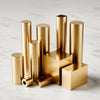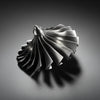CNC Machining Replaces Traditional Machining Methods, have Efficiency Really been Enhanced?

1.The Inevitable Result of Technological Innovation
In the 1950s, the tolerance of General Motors' auto parts was as high as ±0.5mm. But now, the precision of the same parts can reach ±0.02mm. On the other hand, the machining time was shortened from 15 hours to 1.5 hours. By 2024, the CNC services market reached $7.28 billion, projected to grow to $10.79 billion by 2033 (CAGR: 4.47%). This change had led to a redefinition of the whole manufacturing industry.
2.Control Systems: Brain vs. CPU
Factors |
Traditional Machining |
CNC Machining |
| Operation |
|
|
| Skill Dependency |
|
|
3. Precision & Repeatability: The Tolerance Control
(Analyze the company's auto parts data in the past three years)
| Parameter | Manual Mill | CNC Machining |
|---|---|---|
| Dimensional Accuracy | ±0.1 mm | ±0.025 mm |
| Surface Finish (Ra) | 3.2–6.3 μm | 0.4–1.6 μm |
| Batch Consistency | 65% within spec | 98.7% within spec |
| Positional Error | 0.15 mm | 0.005 mm |
4. Machining Capability: What Can Do, What Can Not Do
| Factors | CNC Machining | Traditional Machining |
|---|---|---|
| Geometries | ✅ Can do: Complex geometries is available, such as impeller and special-shaped parts. ❌ Cannot do: Has internal structure but outside sealed. |
❌ Cannot do: Complex shapes. ✅ Can do: Simple curves and flat. |
| Material Compatibility | ✅ Can do: Metals, plastics, alloy metals. ❌ Cannot do: Elastic/viscous materials such as rubber, ceramics (>65 HRC). |
✅ Can do: All materials CNC handles and soft/elastic items ❌ Cannot do: Brittle materials like glass |
| Production Volume | ✅ Can do: Prototyping and mass production. ❌ Cannot do: / |
✅ Can do: Prototypes, repairs. ❌ Cannot do: High-volume project. |
5.Cost Structure Comparison
| Cost Factor | CNC Machining | Traditional Machining |
|---|---|---|
| Machine Cost | ❌ High: $50k-500k | ✅ Low: $5k–$50k (basic lathes/mills) |
| Labor Cost | ✅ Low: 1 operator runs 4+ machines 8+hrs |
❌ High: Need 5+ years of experience technicians |
| Setup Cost | ❌ High: Programming ($50–$300/hr) and fixture | ✅ Low: Manual adjustments (<1 hr) |
| Energy Consumption | ❌ High: 10–50 kW/hr ($1.5-$7) | ✅ Low: 3–15 kW/hr ($0.4-$2) |
6.Conclusion
Traditional machines, especially milling machines, are lower in precision than CNC machine. Also due to the machine structure , traditional machines are hard to finish complex curved. However, in some of simple structure prototyping, traditional machining still has a certain cost-effectiveness, because this process does not require programming, and traditional machines are cheaper than CNC, also their energy consumption are relatively low.
So, the best solution is to combine these two processes. For complex parts with high tolerance or high volume of parts, full CNC machining is recommend. And for some simple structure parts, traditional machining have the cost advantage.
-
Posted in
cnc machining, machining cost





